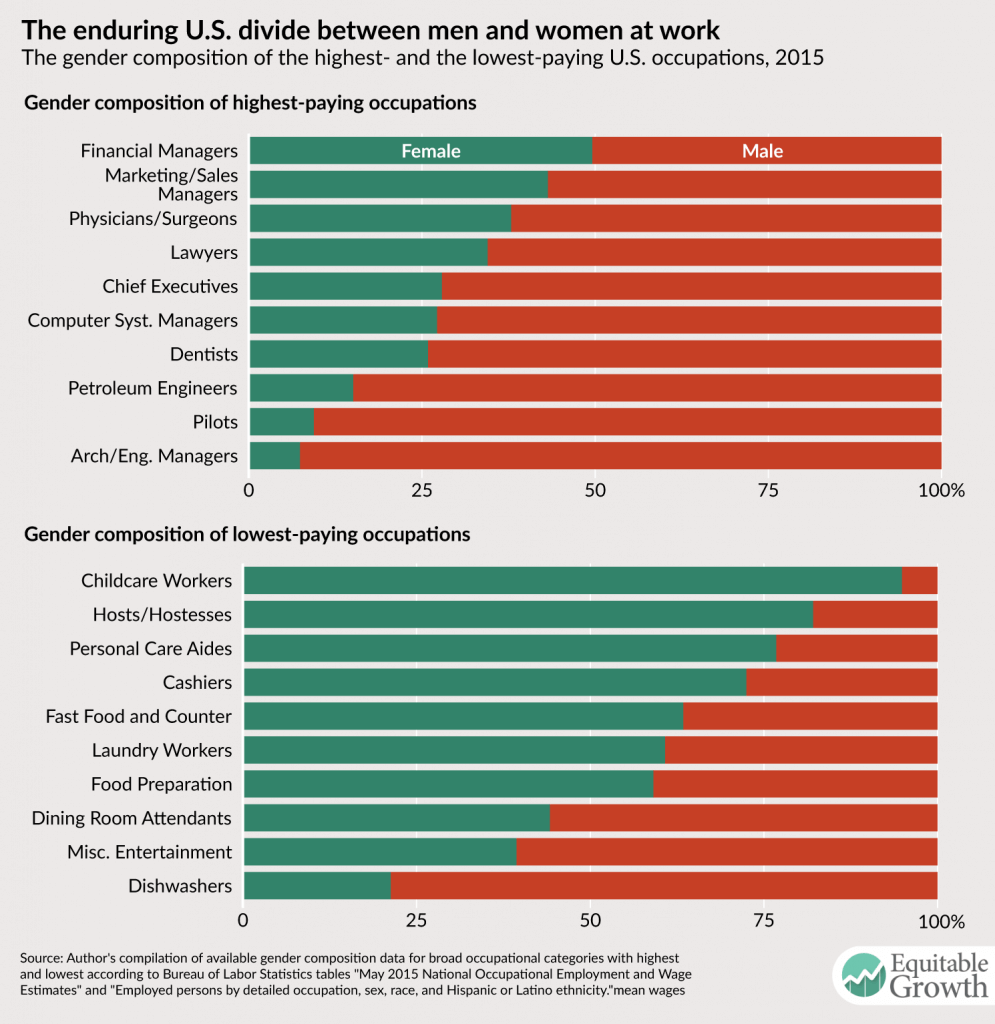Fact sheet: Occupational segregation in the United States
Occupational segregation occurs when one demographic group is overrepresented or underrepresented among different kinds of work or different types of jobs. In 2015, for example, men were 53 percent of the U.S. labor force1, but held less than 30 percent of the jobs in education and more than 98 percent of the jobs in construction.2
Download FileOccupational segregation in the United States
Read the full PDF in your browser
The evidence shows that occupational segregation based on gender occurs more because of assumptions about what kinds of work different genders are best suited for than because of an efficient allocation of innate talent. To the extent to which that is true, occupational segregation hurts economic growth because:
- It depresses productivity and growth by limiting the economically optimal matching of workers’ skills with jobs.
- It depresses the labor force participation rate because workers are less apt to adapt to changes in the economy by taking jobs in growing sectors due to perceptions about which occupations correspond to which gender identifications.
- It depresses aggregate demand in the economy by substantially depressing female wages, contributing to the gender wage gap, and therefore reducing families’ incomes.
Key takeaways
- Occupations with more men tend to be paid better regardless of skill or education level.3 This is because if work is done predominantly by women, then it is valued less in the labor market. As the rate of women working in a given occupation increases, the pay in that occupation declines—even when controlling for education and skills.4
- This trend is also highly racialized: Women of color at all education levels are segregated into jobs with lower wages than their white female peers of similar skill levels.5
- Occupational integration since 1960 was responsible for 60 percent of real wage growth (after accounting for inflation) for black women, 40 percent for white women, and 45 percent for black men.6
- Half of the gender wage gap since 1980 can be attributed to women working in different occupations and industries than men, making it the single largest factor. Discrimination accounts for another 38 percent.7
- While the prevalence of women in low-paid occupations is due to negative biases about the market value of “women’s work,” the prevalence of men in highly paid occupations is often due to workplace cultures that demand long hours and facetime in the office, which does not accommodate flexibility for caregiving.9 (See Figure 1.)
Figure 1

- Many of the occupations that will add the most jobs by 2024, including health care support, administrative assistance, early childhood care and education, and food preparation and services, are composed of more than 60 percent women.10
- The shift in the economy from occupations that have traditionally been male-dominated—namely manufacturing—to ones that are female-dominated and low-paid has implications for the structure and strength of U.S. families. As men’s economic position declines relative to women’s, the prevalence of marriage declines and the fraction of children born to poor single-parent households increases.11
To learn more on this subject from the Washington Center for Equitable Growth
Gender segregation at work: ‘separate but equal’ or ‘inefficient and unfair’
Will McGrew, August 2016
Do U.S. women choose low-paid occupations, or do low-paid occupations choose them?
Bridget Ansel, April 2017
Local economic decline affects marriage and fertility rates, but in a surprising way
Bridget Ansel, February 2017
Many of the fastest growing jobs in the United States are missing men
Bridget Ansel, December 2016
End Notes
1. U.S. Bureau of Labor Statistics, “Civilian Labor Force Level: Men (LNS11000001) and Civilian Labor Force (CLF16OV)” (2017), available at https://fred.stlouisfed.org/series/LNS11000001.
2. U.S. Census Bureau, “2015 American Community Survey” (2015), available at https://www.census.gov/people/io/.
3. Elyse Shaw and others, “Undervalued and Underpaid in America: Women in Low-Wage, Female-Dominated Jobs” (Washington: Institute for Women’s Policy Research, 2016), available at https://iwpr.org/publications/undervalued-and-underpaid-in-america-women-in-low-wage-female-dominated-jobs/.
4. Asaf Levanon, Paula England, and Paul Allison, “Occupational Feminization and Pay: Assessing Causal Dynamics Using 1950-2000 U.S. Census Data,” Social Forces, 88 (2) (2009): 865–891, available at https://academic.oup.com/sf/article/88/2/865/2235342/Occupational-Feminization-and-Pay-Assessing-Causal.
5. Olga Alonso-Villar and Coral del Rio Otero, “The Occupational segregation of Black women in the United States: A look at its evolution from 1940 to 2010” (Verona, Italy: Society for the Study of Economic Inequality, 2013), available at http://econpapers.repec.org/paper/inqinqwps/ecineq2013-304.htm.
6. Chang-Tai Hsieh and others, “The Allocation of Talent and U.S. Economic Growth” (2016), available at http://klenow.com/HHJK.pdf.
7. Francine D. Blau and Lawrence M. Kahn, “The Gender Wage Gap: Extent, Trends, and Explanations.” Working Paper 21913 (National Bureau of Economic Research, 2016), available at http://www.nber.org/papers/w21913.pdf.
8. Chang-Tai Hsieh and others, “The Allocation of Talent and U.S. Economic Growth.”
9. Claudia Goldin, “A Grand Gender Convergence: Its Last Chapter,” American Economic Review 104 (4) (2014): 1091–1119, available at https://scholar.harvard.edu/files/goldin/files/goldin_aeapress_2014_1.pdf.
10. Elyse Shaw and others, “Undervalued and Underpaid in America: Women in Low-Wage, Female-Dominated Jobs.”
11. David Autor, David Dorn, and Gordon Hanson, “When Work Disappears: Manufacturing Decline and the Falling Marriage-Market Value of Men,” (2017), available at http://www.ddorn.net/papers/Autor-Dorn-Hanson-MarriageMarket.pdf.







